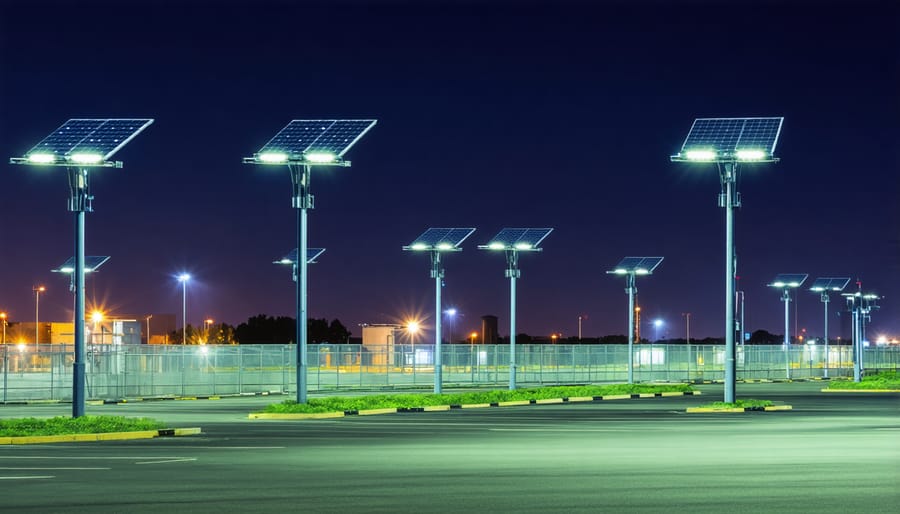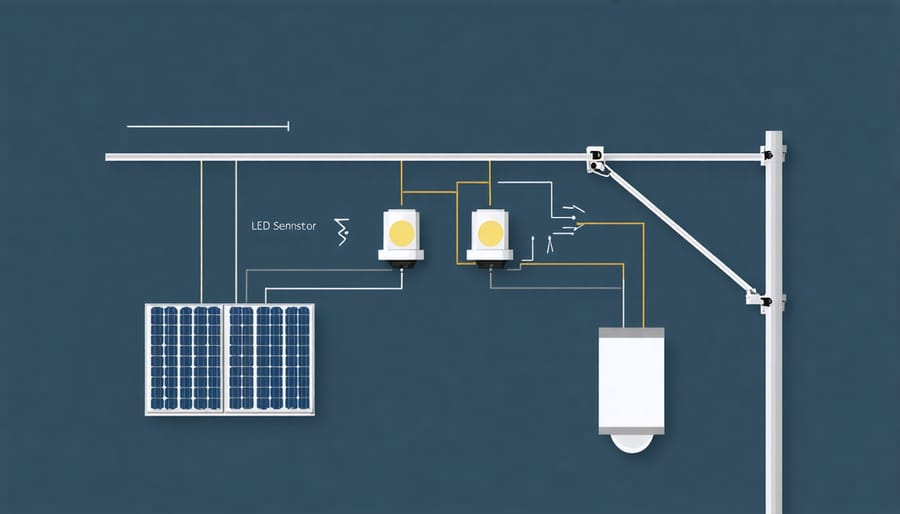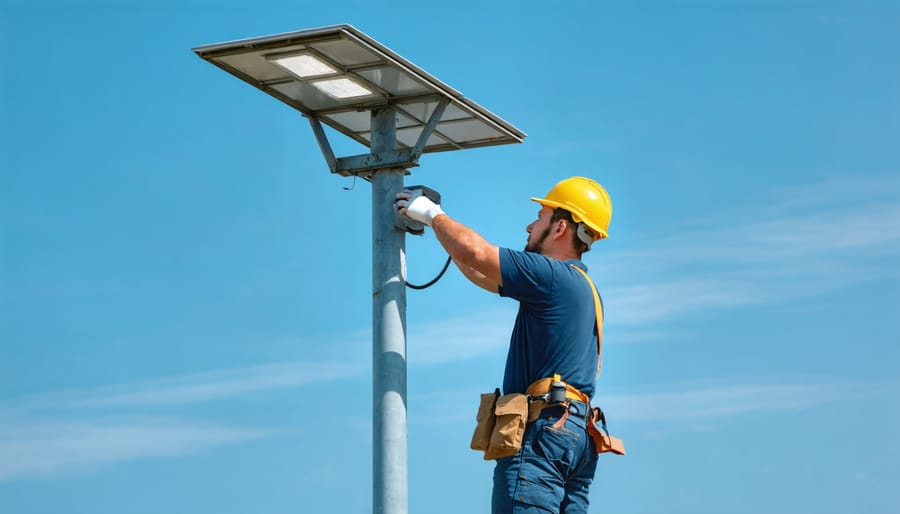Solar Industrial Lights: Power Your Facility’s Safety with Zero Energy Bills
Transform your industrial facility’s safety and sustainability with solar-powered lighting solutions that meet rigorous industrial lighting standards while eliminating energy costs. These advanced illumination systems harness renewable energy to deliver reliable, bright light exactly where it’s needed, operating independently of the power grid during outages and emergencies.
Modern solar industrial lights combine high-efficiency LED technology with smart energy management systems, providing up to 12 hours of consistent illumination after sunset. Their maintenance-free design and robust construction withstand harsh weather conditions, making them ideal for warehouses, manufacturing plants, and outdoor storage facilities.
By integrating motion sensors and automated dimming features, these systems maximize energy efficiency while ensuring workplace safety. Facility managers report up to 70% reduction in lighting-related operational costs after switching to solar solutions, with most installations paying for themselves within 3-5 years through eliminated utility bills and reduced maintenance requirements.
Whether illuminating loading docks, security perimeters, or vast storage yards, solar industrial lights offer a practical, environmentally responsible solution that enhances both safety and operational efficiency.

Why Solar Industrial Lights Are Revolutionizing Facility Safety
Cost Savings Beyond the Electric Bill
The financial benefits of solar industrial lights extend far beyond simply helping to reduce energy costs. One of the most significant advantages is the minimal maintenance required, as LED components typically last 50,000 to 100,000 hours without replacement. This durability translates to substantial savings on labor costs and replacement parts over time.
Property owners can also take advantage of various tax incentives and rebates. The federal Investment Tax Credit (ITC) allows businesses to deduct 30% of their solar lighting installation costs from their taxes. Many states and local utilities offer additional incentives, potentially covering up to 50% of the initial investment.
Moreover, solar industrial lights eliminate the need for trenching and underground wiring during installation, saving thousands in construction costs. Insurance companies often offer reduced premiums for properties with solar lighting due to enhanced security and reduced fire risks. When combined with smart controls and motion sensors, these systems can optimize light output based on actual needs, further maximizing cost efficiency.
Reliable Protection During Power Outages
One of the most valuable features of solar industrial lights is their ability to provide reliable illumination during power outages. Unlike traditional grid-dependent lighting systems, solar lights continue operating even when the main power supply fails, ensuring your facility remains safely lit during emergencies.
These autonomous lighting solutions store excess solar energy in high-capacity batteries, typically providing 3-5 days of backup power during cloudy weather or grid failures. The smart energy management systems automatically switch to battery power when needed, ensuring seamless operation without any manual intervention.
During extended power outages, solar industrial lights maintain essential visibility in parking lots, walkways, and security zones. This reliable backup power capability is particularly crucial for facilities that require 24/7 operation or have strict safety protocols. Many installations include motion sensors and adjustable brightness settings to optimize battery life during emergency scenarios.
Property managers often report that solar industrial lights have proven invaluable during natural disasters and unexpected power failures, maintaining security and operational continuity when traditional lighting systems fail. This self-reliant nature of solar lighting provides peace of mind and enhanced safety for both employees and visitors.

Essential Features of Modern Solar Industrial Lights
Motion Sensors and Smart Controls
Modern solar industrial lights come equipped with intelligent motion sensors and smart controls that significantly enhance their efficiency and functionality. These automated features ensure lights operate only when needed, maximizing energy conservation while maintaining optimal security and safety.
The motion detection system uses advanced infrared technology to identify movement within a specified range, typically 20-40 feet. When motion is detected, the lights automatically switch to full brightness, providing immediate illumination for safety and security purposes. After a predetermined period without detecting movement, the lights either dim to a power-saving mode or turn off completely.
Smart controls allow facility managers to customize lighting schedules, brightness levels, and sensitivity settings through user-friendly mobile apps or central control systems. Many systems offer features like:
– Adjustable motion sensitivity for different environments
– Customizable light duration after motion detection
– Automatic dusk-to-dawn operation
– Remote monitoring and control capabilities
– Energy consumption tracking and reporting
These intelligent features work together to optimize power usage, extending battery life and reducing maintenance requirements. For example, during full moon nights, the system can automatically reduce brightness levels while maintaining visibility. Some advanced models even learn from usage patterns to predict lighting needs and adjust settings accordingly.
The combination of motion sensors and smart controls ensures your solar industrial lights deliver maximum efficiency without compromising on performance or security.
Weather-Resistant Construction
Solar industrial lights are engineered to withstand nature’s toughest challenges, offering exceptional weather-resistant performance in all conditions. Built with industrial-grade materials, these lighting systems feature robust aluminum housings and tempered glass covers that protect the internal components from rain, snow, dust, and extreme temperatures.
The durability of these lights starts with their IP65 or higher waterproof rating, ensuring that moisture can’t penetrate the housing even during heavy storms. Most models can operate effectively in temperatures ranging from -4°F to 140°F (-20°C to 60°C), making them suitable for both frigid winters and scorching summers.
The solar panels themselves are coated with specialized materials that resist UV damage and prevent degradation from prolonged sun exposure. Anti-corrosive treatments protect metal components from rust and oxidation, while impact-resistant materials guard against damage from hail and debris.
Smart drainage systems prevent water accumulation, and condensation-prevention features maintain clear lighting even in humid conditions. The mounting brackets and hardware are equally robust, using stainless steel components that won’t weaken over time.
These weather-resistant features ensure your investment maintains optimal performance year after year, reducing maintenance needs and replacement costs while providing reliable illumination regardless of environmental challenges.
Installation and Maintenance Made Simple
Positioning for Maximum Solar Exposure
Proper positioning of your solar industrial lights is crucial for maximizing their efficiency and performance. Start by conducting a solar path analysis of your site during different seasons. The ideal mounting location should receive direct sunlight for at least 6-8 hours daily, with peak exposure during midday hours when sunlight is strongest.
For northern hemisphere installations, orient your solar panels facing true south (not magnetic south) for optimal sunlight capture. Adjust the tilt angle of your panels based on your geographical latitude – typically your latitude plus 15 degrees in winter, or minus 15 degrees in summer. For fixed installations, setting the tilt angle equal to your latitude provides the best year-round performance.
Avoid placing solar lights where shadows from buildings, trees, or other structures might block sunlight during key charging hours. Consider seasonal changes in sun position and vegetation growth when planning placement. Mount lights high enough to prevent snow accumulation in winter climates and ensure panels stay clear of debris.
For maximum efficiency, clean your solar panels regularly and trim any encroaching vegetation. Remember that even partial shade can significantly reduce charging efficiency, so prioritize completely unobstructed locations whenever possible.

Seasonal Maintenance Tips
Keeping your solar industrial lights in optimal condition requires attention to seasonal maintenance requirements. Start each spring by thoroughly cleaning the solar panels with a soft cloth and mild soap solution to remove accumulated dirt and debris. During summer months, check monthly for dust buildup and clean as needed to maintain maximum charging efficiency.
In autumn, trim any nearby vegetation that might cast shadows on the panels, and clear fallen leaves that could obstruct sunlight. Winter maintenance is particularly crucial – remove snow promptly and ensure panels are tilted at the optimal angle to capture available sunlight. Keep the motion sensors clean and unobstructed throughout the year.
Inspect mounting hardware quarterly for signs of rust or loosening, and tighten as necessary. Check the battery compartment seals during rainy seasons to prevent moisture damage. Replace batteries every 2-3 years, or when you notice decreased performance. Monitor LED fixtures for any signs of water ingress or damage, especially after severe weather events.
For best results, maintain a log of cleaning dates and component inspections. This helps track performance patterns and anticipate when replacements might be needed.
Real-World Success Stories
The Smith Manufacturing facility in Arizona demonstrates the transformative power of solar industrial lighting. After installing 50 solar-powered LED lights across their outdoor storage yard in 2021, they reported a 65% reduction in energy costs and improved security conditions. Plant manager Sarah Chen notes, “The investment paid for itself within 18 months, and we haven’t had a single security incident since installation.”
In Portland, Oregon, the Pacific Northwest Distribution Center successfully implemented solar industrial lights throughout their 12-acre facility. Operations director Mike Johnson shares, “During the recent winter storms, our solar lights kept operating while neighboring facilities experienced power outages. The backup battery system proved invaluable for maintaining operations.”
The Houston Port Authority’s switch to solar industrial lighting in 2020 showcases the durability of these systems. Despite experiencing Hurricane Laura, all 200 solar fixtures remained functional, providing critical illumination during the recovery period. “The robust design and weather-resistant construction exceeded our expectations,” states facility coordinator Tom Martinez.
A particularly inspiring example comes from the Boulder Tech Campus, where the installation of 75 solar industrial lights contributed to their LEED certification. The project reduced their carbon footprint by 40 metric tons annually while providing better illumination for late-shift workers. Sustainability manager Lisa Wong explains, “The improved light quality and reliability have positively impacted worker safety and morale, while supporting our environmental goals.”
These success stories highlight how solar industrial lighting solutions deliver on their promises of reliability, cost savings, and environmental benefits across diverse settings and challenges.
Solar industrial lights represent a revolutionary step forward in sustainable facility lighting solutions, combining cost-effectiveness with environmental responsibility. Throughout this guide, we’ve explored how these innovative systems harness the sun’s power to deliver reliable, bright illumination while significantly reducing energy costs and carbon footprints.
From enhanced security features to minimal maintenance requirements, solar industrial lights offer compelling advantages that make them an attractive choice for forward-thinking facility managers and property owners. The initial investment is quickly offset by eliminated electricity bills and reduced maintenance costs, while the environmental benefits continue to multiply year after year.
As we face increasing environmental challenges and rising energy costs, the transition to solar industrial lighting isn’t just a smart business decision – it’s a necessary evolution in how we light our industrial spaces. By choosing solar-powered solutions, you’re not only investing in your facility’s future but contributing to a more sustainable planet.
Take the first step toward a brighter, more sustainable future by exploring solar industrial lighting options for your facility. The technology is proven, the benefits are clear, and the time to make the switch is now.











